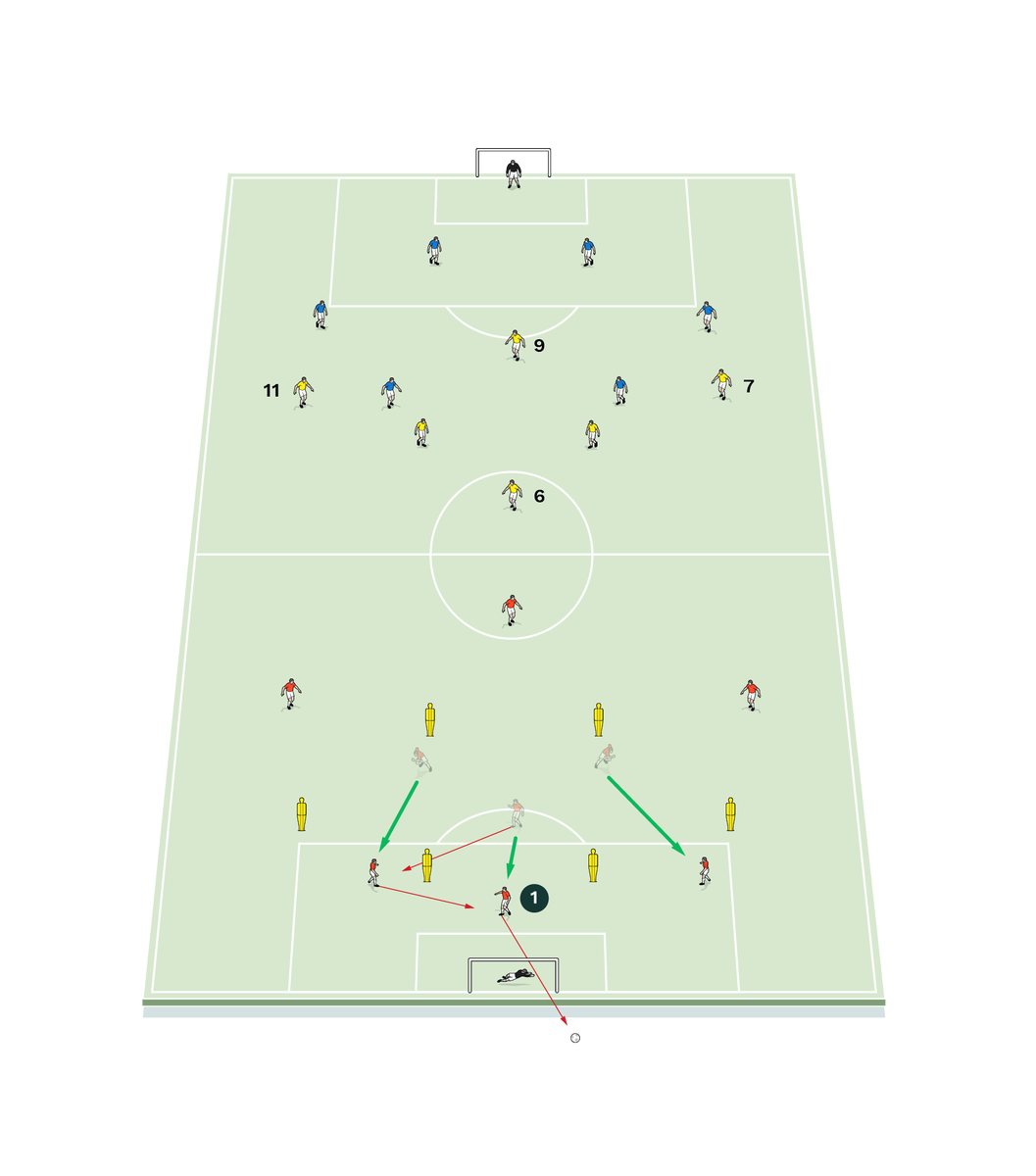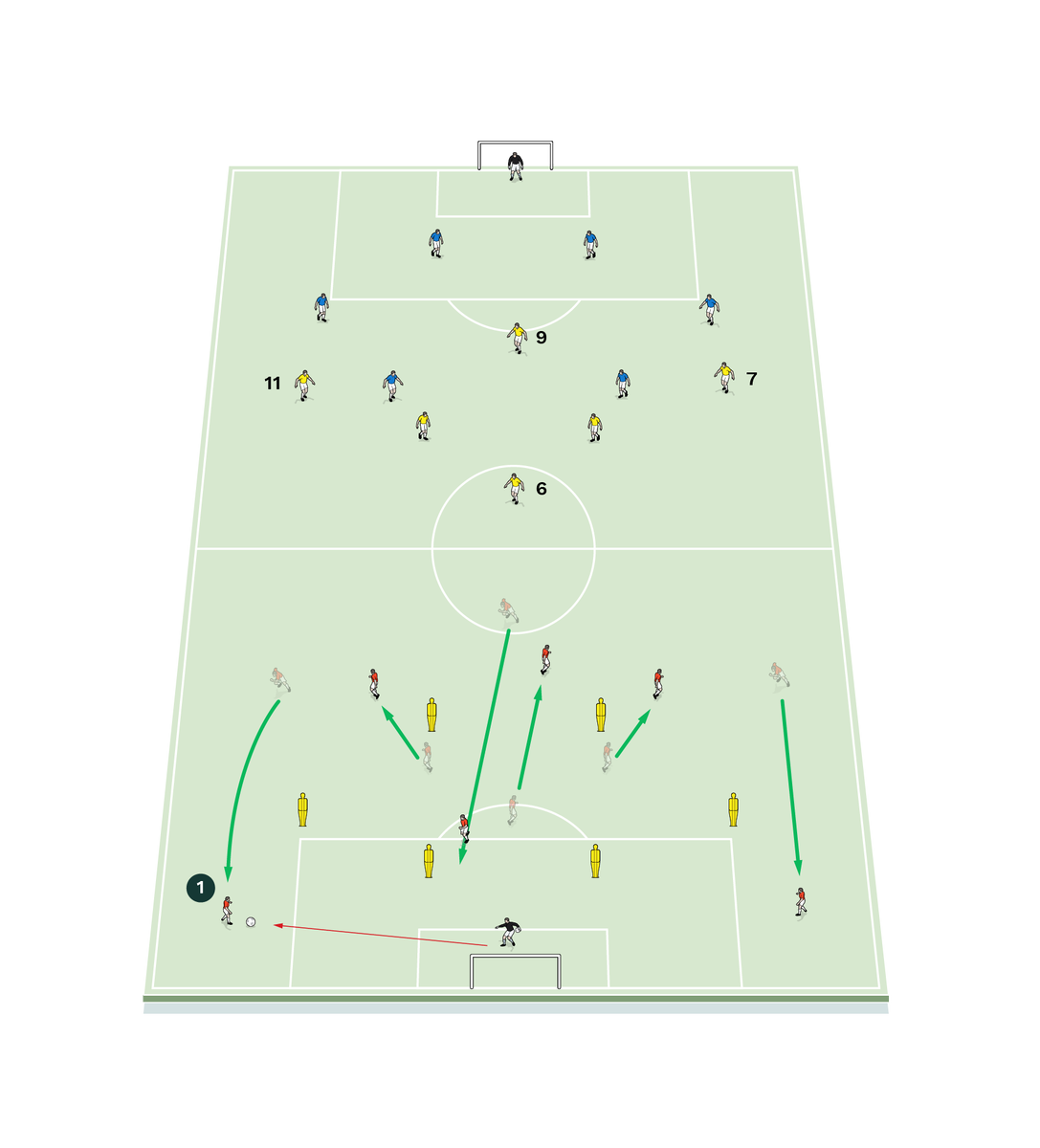You are viewing 1 of your 1 free articles
6v6+6 build v break
The session consists of 18 players in three teams of six. The ideal scenario is to use this practice straight after some unopposed build-up or shape work. The theme is all around building towards the goal, but the beauty of the session is that you can coach pretty much any topic both with and without the ball.
| Area | Full pitch |
| Equipment |
Full size goals, mannequins |
| No. of Players | 18 + goalkeeper |
| Session Time |
25mins
|
The session consists of 18 players in three teams of six. The ideal scenario is to use this practice straight after some unopposed build-up or shape work. The theme is all around building towards the goal, but the beauty of the session is that you can coach pretty much any topic both with and without the ball. In this case, the focus is around building through the pitch - first, second and final thirds - using key movements and triggers.
The session is unique due to its ability to engage all three groups at once with specific outcomes at the same time. Teams 1 and 2 are playing an attack v defence in one half, while team 3 are awaiting their time to trigger three balls in a build phase towards goal and finally a fourth ball to build out back towards the 6v6 game to restart that. The practice also utilises more than one coach to focus on different phases of the practice, and it also heavily includes the goalkeeping coach and a variety of restarts via their creative service into the goalkeeper.
This session is fantastic on MD-2. Typically each group will have two sets of each role, and it ticks a lot of boxes physically on top of the clear tactical foci. It’s also a full-pitch session so you get realistic distances and good high-speed running numbers from typical positions.
BUILD V BREAK
Set up your three teams as shown. The red team (Team 1) will attack the goal with six players in a 4-3-3 formation using the front six. It would look like this - 6, left 10, right 10, 7 and 11 on the sides, and a 9. They start the practice by attacking the blue team (Team 2) who have their goalkeeper in place, a back four, and two holding players set up to defend their goal. They are seeking to score [1a].
[1a]

-
Red team attack blue team, looking to score a goal
If they do, they are rewarded with another ball. If they lose possession, then they are looking to regain and go, or reset their positions in order to defend the halfway line and stop the blue team from serving the yellow team (Team 3) who are waiting in the opposite half. Do they stay or do they swap?
The blue team (Team 2) defend against the red team with a back four and two screening midfield players. They are tasked with defending their box and attempting to regain or at least restrict the red team from hurting their shape and attacking their goal. If the ball goes dead for a throw-in or goal kick, the blue team will try to build out towards the halfway line and the awaiting third team in the other half. Their task is to play through, around or over Team 1 into Team 3 [1b]. If they are successful in doing so, Team 2 and 1 walk and swap roles of who is attacking the goal.
[1b]

-
Blue team look to gain the ball and serve it to yellow team
The yellow team (Team 3) are in the other half and will play against set-out mannequins who will mimic the shape of what we will face on matchday. They are waiting to be served by Team 2 to start their practice [1c].
[1c]

-
Yellow team begin practice
They have three balls once they begin: ball 1 served in from Team 2 or the coach, ball 2 served wide to attack a late cross [1d] ...
[1d]

-
Second ball for yellow team - served wide, late cross
... ball 3 from coach into the forward to combine and finish [1e].
[1e]

-
Third ball for yellow team - served by coach into forward, combination and finish
Then a final ball is served into the goalkeeper, and Team 3 flip and build out back towards the 6v6 to serve that game to restart [1f].
[1f]

-
Yellow team then flip and build from the back to serve into the other half
There are various ways to develop this session, all dependent on theme and topic. It can fall nicely into a three-team wave game fully opposed, which is something I have done regularly. This helps bring the reality of transition and full-pitch momentum into life.
COACHING POINTS
What are the key things to look out for technically and tactically?
Tactically, you can make this practice unique to your team’s chosen identity. What do you want from the 10s? Or the wingers? How do you want the last line occupied? What about how you want to defend the halfway line when you lose the ball? There is a lot to consider, but the most important things are what’s important to you and the team’s clarity on how you want to play football.
Technically, this has everything: extreme combinations, passing and running, one- and two-touch finishes as well as detail of pass and movement to receive in different areas, heights and lines.
What are the typical mistakes that players might make, and how do you avoid them?
Typically players need to see the first set to gauge the flow. The coaches’ roles within this are also super-important to create a good state of flow and allow everyone included to be on their toes and engaged.
Related Files
Editor's Picks
Using the goalkeeper in build-up play
Pressing principles
Intensive boxes drill with goals
Penetrating the final third
Creating and finishing
My philosophy
Pressing initiation
Compact team movement
Defensive organisation
Coaches' Testimonials

Alan Pardew

Arsène Wenger

Brendan Rodgers

Carlos Carvalhal

José Mourinho

Jürgen Klopp

Pep Guardiola

Roy Hodgson

Sir Alex Ferguson

Steven Gerrard
Related
Playing out vs high press
Pressing and transition
Rousing, responsive and resilient
Gareth Taylor: The path to success
Coaches' Testimonials

Gerald Kearney, Downtown Las Vegas Soccer Club

Paul Butler, Florida, USA

Rick Shields, Springboro, USA

Tony Green, Pierrefonds Titans, Quebec, Canada
Join the world's leading coaches and managers and discover for yourself one of the best kept secrets in coaching. No other training tool on the planet is written or read by the calibre of names you’ll find in Elite Soccer.
In a recent survey 92% of subscribers said Elite Soccer makes them more confident, 89% said it makes them a more effective coach and 91% said it makes them more inspired.
Get Monthly Inspiration
All the latest techniques and approaches
Since 2010 Elite Soccer has given subscribers exclusive insight into the training ground practices of the world’s best coaches. Published in partnership with the League Managers Association we have unparalleled access to the leading lights in the English leagues, as well as a host of international managers.
Elite Soccer exclusively features sessions written by the coaches themselves. There are no observed sessions and no sessions “in the style of”, just first-hand advice delivered direct to you from the coach.









